Dog Breed Traits: Grooming
By Michele Welton, Dog Trainer, Breed Selection Consultant, Author of 15 Dog Books
Fencing needed for confinement
Risk of Aggression Toward People
Risk of Aggression Toward Other Dogs
When you see a beautiful dog, you might say, "I should get that kind of dog! Such a lovely coat!"
But don't stop there. Ask yourself, "What would this lovely coat require from me? Would I be happy doing that amount of coat care? Am I the right owner for a dog with this type of coat?"
Brushing
Let's find out how much brushing and combing you're willing and able to do.
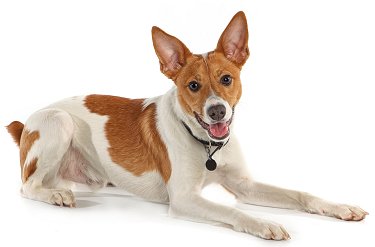
MINIMAL brushing for this Rat Terrier.
MINIMAL BRUSHING
You can easily brush dirt and loose hair from a short coat like a Beagle, Labrador Retriever, or Boxer. Just be aware that most of these short coats shed quite a bit. Sometimes this shocks people who thought only longhaired dogs shed. Nope. Short coats are enthusiastic shedders!
Good news... you can turn a longhaired breed into a shorthaired breed, with scissors or clippers. Then you will only need to do minimal brushing – but to keep the coat short, you must repeat the trimming/clipping every few months.
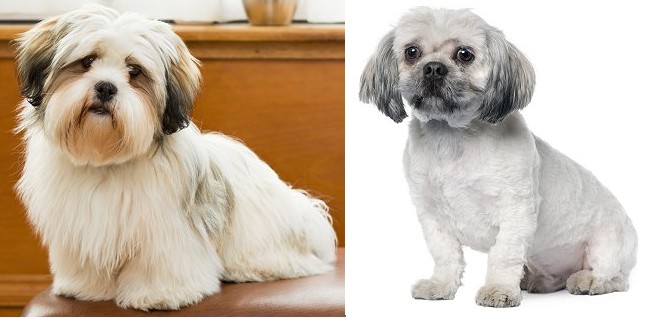
SIGNIFICANT brushing for the Havanese on the left. MINIMAL brushing for the trimmed/clipped Havanese on the right.
MODERATE BRUSHING
Are you willing to do regular brushing and combing, say twice a week? Some dog breeds require moderate brushing to keep their coat clean, to control shedding, and/or to prevent mats and tangles.
There are three types of coats that need moderate brushing: thick coats, wiry/whiskery coats, and feathered coats.
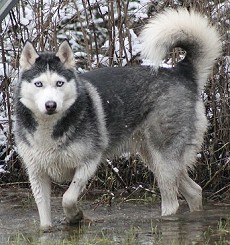
MODERATE brushing for this Siberian Husky.
THICK COATS
Thick coats are made up of TWO coats – a primary outercoat and a secondary undercoat, creating a protective double layer that keeps the dog warm and dry(ish) in cold/wet weather.
Note that thick coats shed a lot. Frequent brushing helps pull off dead shedding hairs before they end up on your clothes and furniture!
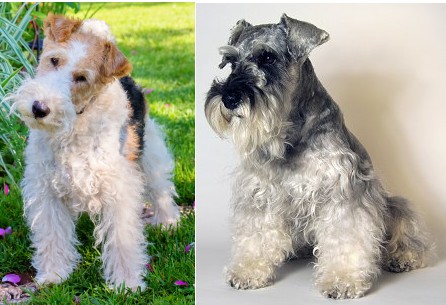
MODERATE brushing for this Fox Terrier and Miniature Schnauzer.
WIRY/WHISKERY COATS
A dog with wiry hair and a whiskery face, like a terrier or schnauzer, needs moderate brushing. Special attention must be paid to the beard because it gets filthy when the dog eats and drinks.
It is possible to trim/clip these coats very short on a regular basis, removing even the beard. The dog stays cleaner and more comfortable and brushing becomes a snap.
FEATHERED COATS
A dog with a FEATHERED coat has a short(ish) coat on his torso, with longer feathering on his ears, the back of his legs, chest and stomach, hindquarters, and tail.
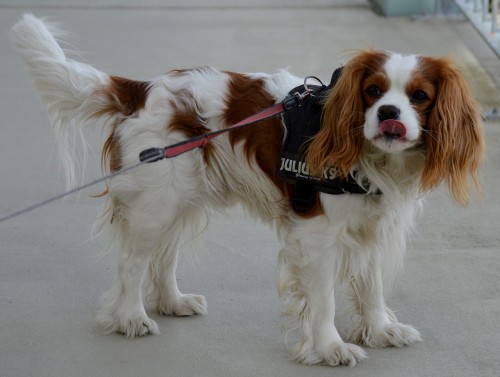
MODERATE brushing for this Cavalier King Charles Spaniel.
Within each breed, individual dogs will always have less (or more) feathering than others. I'm sure you can guess which of these two Cavalier pics will be easier (or more tedious) to manage!
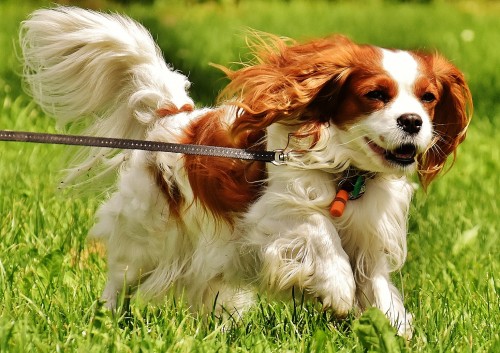
MODERATE-PLUS brushing for this heavily-coated Cavalier.
Caution! Feathering looks lovely, but you must regularly use a brush and comb to keep the long hairs from twisting and tangling together into mats.
LOTS OF BRUSHING
By "lots" of brushing, I mean 10-20 minutes every other day, brushing and combing a long coat.
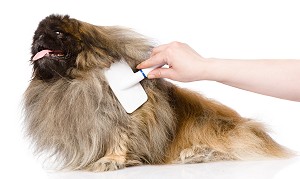
LOTS of brushing for this Pekingese.
Don't neglect a long coat! When the hair starts to tangle together, you must quickly tease those hairs apart. Otherwise they will "fuse" into mats that are a breeding ground for parasites and bacteria. Matted hair also tugs painfully on the skin when the dog tries to walk or lie down.
Now, there is a way to minimize all this brushing and combing. You use scissors or clippers to shear the coat short. It will grow back, of course, so you'll need to repeat it.
Everyone is different, so only YOU know whether you'd rather brush/comb every other day, or trim/clip every few months.
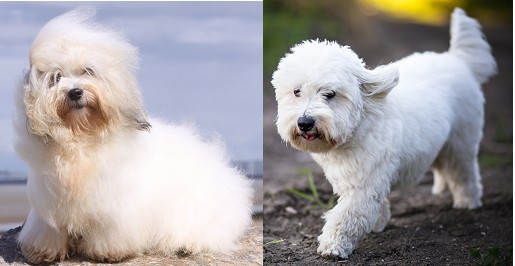
LOTS of brushing required for the Coton de Tulear on the left. Only MODERATE brushing needed for the trimmed Coton on the right.
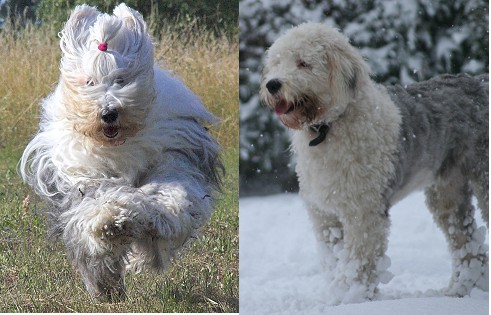
LOTS of brushing required for the Old English Sheepdog on the left. Only MODERATE brushing for the trimmed Sheepie on the right.
Trimming/clipping
Trimming and clipping are done with scissors and electric clippers. You can learn to do this yourself – it isn't difficult, especially for smallish dogs. Or you can pay a professional groomer every few months.
So let's find out how much trimming/clipping you're willing and able to do:
NO TRIMMING
Labradors, Beagles, Great Danes, Rottweilers.... obviously no trimming or clipping. Lots of choices here!
SOME TRIMMING
Some coats include longish hair under the dog's tail and in his groin/pelvic area.
You should keep these areas trimmed or clipped so they stay clean and sanitary when the dog goes to the bathroom. It's no fun when you let your dog out to potty and he comes back in with urine dripping from the long hair around his penis and fecal matter stuck to all the hair under his tail... and then he jumps up on your bed or sofa.
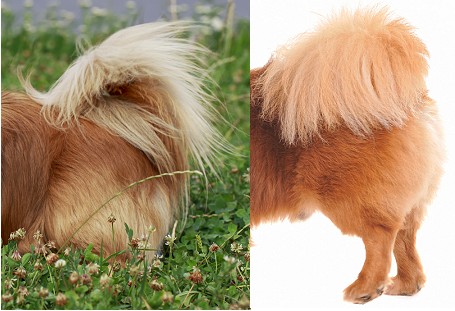
The Pekingese on the left is going to get dirty back there! The Pekingese on the right will stay neat and clean.
These same coats might also have long hair around their ears, feet, chest and stomach. This should be trimmed also, to prevent mats and tangles. Longish hair is also a magnet for dirt and debris, leaves and snow, which then gets tracked into your house. You can minimize these issues by keeping this longish hair trimmed back.
Examples of breeds that need SOME trimming:
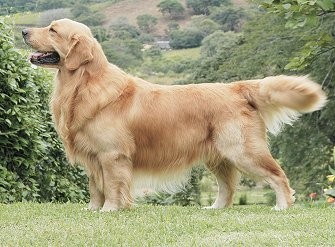
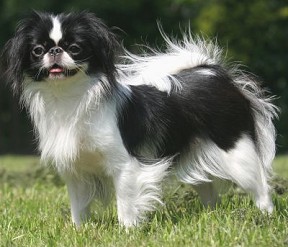
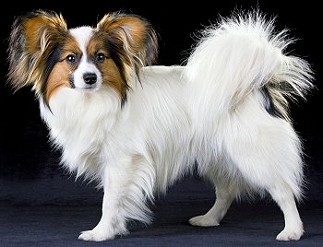
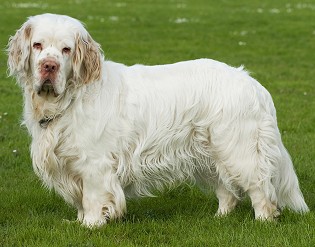
Clockwise: Golden Retriever, Japanese Chin, Clumber Spaniel, Papillon
SIGNIFICANT TRIMMING
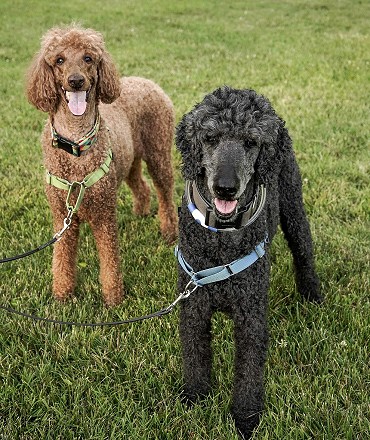
Standard Poodles require significant grooming. Their hair grows continually so must be sheared short every 6-8 weeks.
What does significant mean?
- The anal/groin areas must be clipped free of excess hair, for sanitary pottying.
AND
- The rest of the coat must be scissored or clipped short every few months (for some breeds, more often than that). Otherwise the hair will grow and grow, tangling and knotting into a matted horror show. Grooming neglect can lead to animal abuse charges, so if you get a dog who needs lots of grooming, be sure to keep up!
You can do this trimming and clipping yourself, or you can pay a professional groomer to do it. This is a good example of how you shouldn't choose a dog simply because you like its appearance. Ask yourself: "What kind of care does this dog's coat require? Can I commit to that?" On behalf of dogs everywhere... thank you for thinking of them!
Examples of breeds that need SIGNIFICANT trimming:
Poodles, Bichons, Schnauzers, Bouviers, Portuguese Water Dogs, several spaniel breeds, and numerous terrier breeds.
Your dog will also need significant trimming if his coat is naturally long and you decide to clip it short for ease of brushing and maximum cleanliness. For example, you might choose to brush the naturally long coat of a Havanese... or you might choose to shear the coat short.
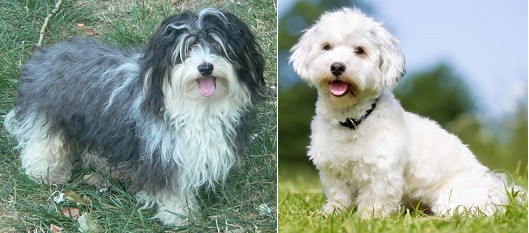
The Havanese on the left needs lots of brushing but only moderate trimming. The Havanese on the right needs minimal brushing but significant trimming. Same breed, but different grooming. Up to you!
My best-selling books – now available FREE on my website
 Respect Training For Puppies: 30 seconds to a calm, polite, well-behaved puppy is for puppies 2 to 18 months old. Your puppy will learn the 21 skills that all family dogs need to know. Click here to read for free.
Respect Training For Puppies: 30 seconds to a calm, polite, well-behaved puppy is for puppies 2 to 18 months old. Your puppy will learn the 21 skills that all family dogs need to know. Click here to read for free. Teach Your Dog 100 English Words is a unique Vocabulary and Respect Training Program that will teach your adult dog to listen to you and do what you say. Click here to read for free.
Teach Your Dog 100 English Words is a unique Vocabulary and Respect Training Program that will teach your adult dog to listen to you and do what you say. Click here to read for free. 11 Things You Must Do Right To Keep Your Dog Healthy and Happy helps your dog live a longer, healthier life. Get my honest advice about all 11 Things before you bring home your new puppy, because some mistakes with early health care cannot be undone. Click here to read for free.
11 Things You Must Do Right To Keep Your Dog Healthy and Happy helps your dog live a longer, healthier life. Get my honest advice about all 11 Things before you bring home your new puppy, because some mistakes with early health care cannot be undone. Click here to read for free.
